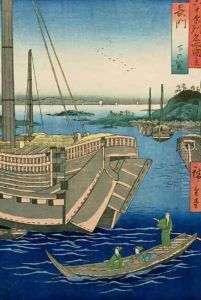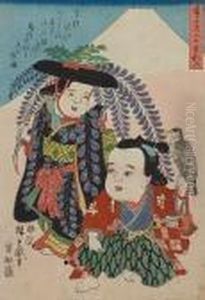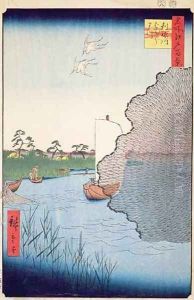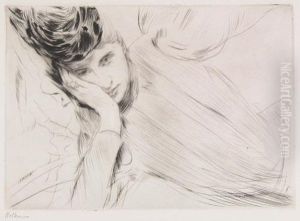





````````tsuchiyama', ````````nihonbashi', ````````ishiyakushi', ````````akasaka', ````````arai', ````````ejiri' And ````````kanaya' From The Series ````````tokaido Gojusan Tsugi'
-
About Reproduction
Discover the allure of art with our faithful reproduction of "````````tsuchiyama', ````````nihonbashi', ````````ishiyakushi', ````````akasaka', ````````arai', ````````ejiri' And ````````kanaya' From The Series ````````tokaido Gojusan Tsugi'", originally brought to life by the talented Utagawa or Ando Hiroshige. Unlike posters or prints, our hand-painted oil painting breathes an unique sense of depth and texture into your space. Every detail, every stroke, and every texture is meticulously recreated, paying the perfect homage to Utagawa or Ando Hiroshige and his artistic vision.
Owning this piece is more than just decoration - it's a statement of your refined taste in art. Let the vibrant colors and intricate details of this replica serve as a daily reminder of the beauty in our world. Elevate your decor and appreciate the richness of art with our replica of this masterpiece.
-
Painting Description
The "Tōkaidō Gojūsan Tsugi" (The Fifty-three Stations of the Tōkaidō) is a renowned series of ukiyo-e woodblock prints created by the Japanese artist Utagawa Hiroshige (also known as Ando Hiroshige) during the Edo period. This series, completed between 1833 and 1834, depicts the scenic beauty and cultural richness of the 53 post stations along the Tōkaidō road, which connected Edo (modern-day Tokyo) to Kyoto. Each print in the series captures the unique characteristics and atmosphere of a specific station, offering a glimpse into the daily life, landscapes, and travel experiences of the time.
Tsuchiyama: This print portrays travelers braving a heavy rainstorm as they cross a bridge over a swollen river. The scene is dynamic, with the slanting lines of the rain creating a sense of movement and urgency. The lush greenery and the turbulent waters emphasize the natural beauty and challenges faced by travelers on the Tōkaidō road.
Nihonbashi: The starting point of the Tōkaidō road, Nihonbashi is depicted bustling with activity. Merchants, samurai, and commoners are shown crossing the iconic bridge, with the cityscape of Edo in the background. This print captures the vibrant energy of the capital and the beginning of the journey along the Tōkaidō.
Ishiyakushi: This station is known for its temple dedicated to Yakushi, the Buddha of healing. Hiroshige's print features pilgrims and travelers visiting the temple, set against a backdrop of serene hills and trees. The composition highlights the spiritual significance of the location and the peaceful ambiance of the countryside.
Akasaka: In this print, Hiroshige depicts a quiet village scene with travelers resting at a tea house. The thatched roofs, winding road, and surrounding fields create a picturesque and tranquil setting. The print conveys a sense of respite and the simple pleasures of rural life.
Arai: Arai is shown as a bustling ferry crossing, with boats transporting passengers and goods across a wide river. The print captures the lively interaction between travelers and boatmen, as well as the expansive waterway that serves as a vital link along the Tōkaidō.
Ejiri: This print features a panoramic view of Suruga Bay, with Mount Fuji majestically rising in the distance. Fishermen and travelers are depicted along the shore, engaging in their daily activities. The composition emphasizes the natural beauty of the coastline and the iconic presence of Mount Fuji.
Kanaya: Kanaya is depicted with travelers crossing the Ōi River, which is shown as a broad, shallow expanse of water. The print captures the effort and cooperation required to navigate this challenging part of the journey. The distant mountains and open sky create a sense of vastness and the arduous nature of travel.
Hiroshige's "Tōkaidō Gojūsan Tsugi" series is celebrated for its masterful use of color, composition, and perspective, which bring to life the diverse landscapes and experiences along the Tōkaidō road. Each print not only serves as a visual record of the journey but also reflects the cultural and historical context of the Edo period.
-
Lead Time & Shipping
When you order this oil painting replica, it typically takes 2-3 weeks to paint. If the artwork is more complex, it might need a little more time to ensure the best quality. Once it's ready, we'll send you a photo for your approval. After you give the green light, we'll ship it to you for free.
-
Return & Refund
We believe in the quality of our hand-painted oil painting reproductions, and your satisfaction is our priority. If for any reason, you are not completely satisfied with your purchase, we offer a 45-day return policy. You can return your artwork within 45 days of receipt and receive a full refund. Please note that the artwork must be returned in the original packaging and in the same condition as it was received.




















